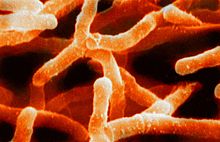
Number of species in the collection: 2.
Pictures of Actinobacteria:








Characteristics of Actinobacteria:
The phylum
Actinobacteria is a group of bacteria with worldwide distribution and high
abundance in soils, on or within animals, in freshwater marine environments, and
on virtually any natural surface.
They are gram-positive bacteria, with a high content of guanine and cytosine in
their DNA and with some species capable of producing external spores. They play
an important role in soil organic matter recycling, as they can decompose a
large number of organic molecules, such as chitin and cellulose, promoting the
formation of humus and soil mineral enrichment. Some species live in symbiosis
with animals, either in their intestines or on their surface, while others are
pathogens, some causing significant human diseases. While most species form more
or less rounded cells, some form branched cells that resemble fungal mycelia.
The phylum Actinobacteria is known for the chemical substances that some of its
species are capable of producing, which have been exploited by pharmaceutical
industries for drug production. For example, the earthy smell produced by soils
in temperate climates after sporadic rains is due to the geosmin, a substance
produced by some species of this group of bacteria.
The following cladogram shows the evolutionary relationships of the main
lineages within the group.

Phylum: Actinobacteria